Cache
je umístena v blízkosti hradu
Landštejn
The cache is placed near
to the castle Landstejn
[CZ]
Hrad Landštejn,
jak již napovídá název, byl
pomezní pevností na neklidné
ceskorakouské hranici a strežil zemskou stezku do
Vitorazska. Podle staršího názoru byli jeho
staviteli rakouské rody hrabat z Raabsu a Zöbingu,
Nejnovejší archeologické výzkumy
této lokality však nepochybne prokázaly,
že starší rakouský hrad byl 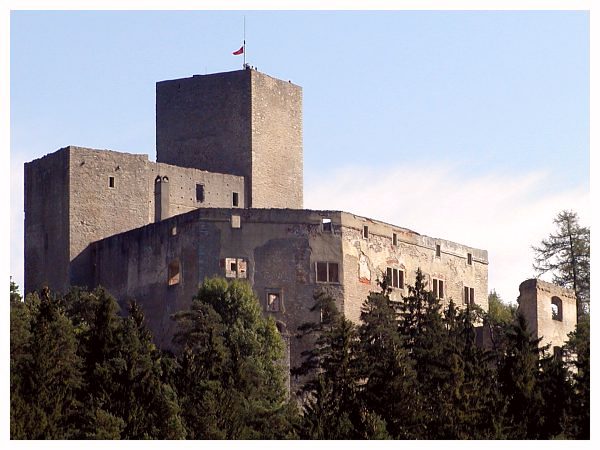 situován v dnešní vesnici Pomezí
naproti Landštejnu a zachovala se z nej dodnes cást
románského kostela.
situován v dnešní vesnici Pomezí
naproti Landštejnu a zachovala se z nej dodnes cást
románského kostela.
Landštejn jako
královský hrad spadal pod správu
moravských Premyslovcu. Kdy a jak získali hrad a
panství Vítkovci není známo.
Víme však, že asi od roku 1259 byl pánem
Landštejna Oldrich, pocházející
nejspíše z trebonské vetve Vítkovcu, po
nem Sezema a Vítek, syn Ojíre z
Lomnice.
Vítkovci,
píšící se podle hradu jako páni
z Landštejna, si získávali osobní
statecností stále vetší
politický vliv. Vítek z Landštejna (+ 1312) se
vyznamenal pri obrane mesta Znojma a mimorádnou statecnost
projevil v zápase s míšenskou posádkou
Pražského hradu za krále Jindricha
Korutanského, kdy stranil Elišce
Premyslovne.
Za Viléma z
Landštejna (+ 1356) obnášelo
landštejnské panství mimo hradu a Nové
Bystrice ješte Trebon, Lomnici a Nové Hrady. Po
pocátecních neshodách prijal Vilém z
Landštejna roku 1317 lenní závazek a stal se
rádcem krále Jana Lucemburského.
Prátelství si udržel i s jeho synem Karlem IV.,
který se stal Vilémovým 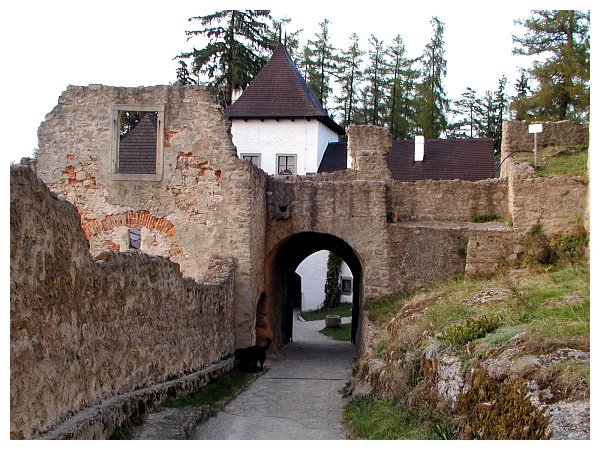 zastáncem v krvavém sporu s bojovným
príbuzným Jindrichem z Hradce. Z
Vilémových šesti synu zdedil Landštejn
Litold, který však zemrel bez detí a hrad
pripadl královské korune.
Roku
1381 získal landštejnské panství od
krále Václava IV. Konrád Krajír z
Krajku, který zastával úrad
nejvyššího hofmistra. Jmenování
zemským hejtmanem v Korutanech v roce 1385 odvedlo
Konráda od pražského dvora, jeho synové
však v Cechách zustali. Landštejn zdedil
Lipolt a jeho syn Wolfgang pak hrad rozšíril a velmi
nákladne prestavel v pozdnegotickém
slohu.
Krajírové
vládli Landštejnu témer dve století a
jejich panování bylo poznamenáno velkým
stavebním ruchem. Za tu dobu podstatne zesílili
opevnení a vybudovali kolem petiúhlého
nádvorí výstavné renesancní
paláce. Stavební cinnost Krajíre však
vycerpala natolik, že po smrti Zdenka II. prodala roku 1579
jeho dcera Anna, provdaná Roupovská, hrad i
panství Rakušanu Štepánovi z Eicinku.
Vzápetí však hrad koupil jihlavský
meštan David Neumaier. Daviduv syn Gottfried se postavil na
stranu odbojných stavu a po jejich porážce na
Bílé hore mu byl majetek konfiskován.
Panství pak rychle menilo majitele.
V
roce 1621 se zde vystrídali Baltazar Marradas a
Kristián Hübner, následujícího
roku byl hrad prodán slavatovskému hejtmanovi Jakubu
Keclovi z Rottendorfu, v
zastáncem v krvavém sporu s bojovným
príbuzným Jindrichem z Hradce. Z
Vilémových šesti synu zdedil Landštejn
Litold, který však zemrel bez detí a hrad
pripadl královské korune.
Roku
1381 získal landštejnské panství od
krále Václava IV. Konrád Krajír z
Krajku, který zastával úrad
nejvyššího hofmistra. Jmenování
zemským hejtmanem v Korutanech v roce 1385 odvedlo
Konráda od pražského dvora, jeho synové
však v Cechách zustali. Landštejn zdedil
Lipolt a jeho syn Wolfgang pak hrad rozšíril a velmi
nákladne prestavel v pozdnegotickém
slohu.
Krajírové
vládli Landštejnu témer dve století a
jejich panování bylo poznamenáno velkým
stavebním ruchem. Za tu dobu podstatne zesílili
opevnení a vybudovali kolem petiúhlého
nádvorí výstavné renesancní
paláce. Stavební cinnost Krajíre však
vycerpala natolik, že po smrti Zdenka II. prodala roku 1579
jeho dcera Anna, provdaná Roupovská, hrad i
panství Rakušanu Štepánovi z Eicinku.
Vzápetí však hrad koupil jihlavský
meštan David Neumaier. Daviduv syn Gottfried se postavil na
stranu odbojných stavu a po jejich porážce na
Bílé hore mu byl majetek konfiskován.
Panství pak rychle menilo majitele.
V
roce 1621 se zde vystrídali Baltazar Marradas a
Kristián Hübner, následujícího
roku byl hrad prodán slavatovskému hejtmanovi Jakubu
Keclovi z Rottendorfu, v 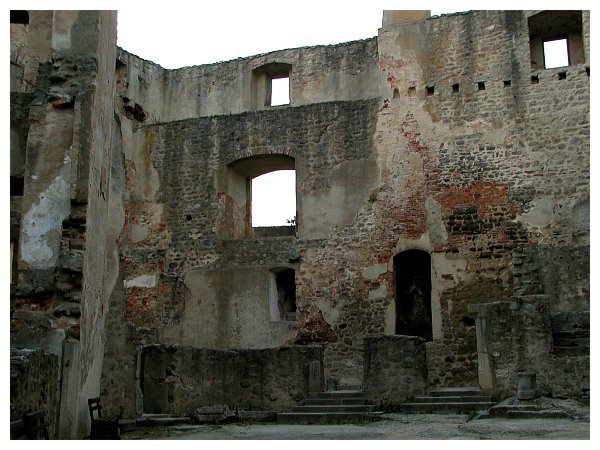 dalším roce se Landštejn dostal do
držení bratrím Maxmiliánovi a
Ferdinandovi Mohrum z Leichteneggu. Od roku 1639 vlastnil
panství Jakub Khuen z Belasy, v roce 1668 prevzal
vládu Humprecht Jan Cernín z Chudenic a jeho syn
Tomáš Zacheus. Roku 1685 koupil panství
císarský generál Ferdinand Arnošt z
Herbersteina. Landštejn, okleštený o
okolní vesnice, vydržel v majetku tohoto rodu až
do roku 1816, kdy smrtí hrabete Josefa rod vymrel. To
však byl hrad od roku 1771, kdy po úderu blesku do
jedné z veží zcela vyhorel, pustý a
sloužil jen jako sýpka. Zrícenina poskytovala
stavební materiál širokému
okolí. Dlouhý spor o dedictví po hrabeti
Josefu z Herbersteina skoncil roku 1846, kdy panství zdedil
baron Ferdinand Sternbach, v jehož rodu zustala
zrícenina hradu až do roku
1945.
Dnešní
Landštejn je jednou z nejzachovalejších
ukázek stredovekého fortifikacního
systému. Nejstarší románská
cást hradu s palácem vestaveným mezi dve
obranné veže je v Cechách ojedinelá.
Pozdejší dostavba gotického opevnení s
obytnou veží donjonem rozšírila hrad o
další nádvorí. Vznosný
ctyrpatrový palác Krajíru z Krajku s
renesancním opevnením a barokní
delostrelecké bašty pak uzavírají
prurez stavebními styly ctyr vývojových etap.
Návštevníci se mohou po areálu hradu
volne procházet nebo sledovat stavební vývoj
hradu z prístupné vyhlídkové
veže.
dalším roce se Landštejn dostal do
držení bratrím Maxmiliánovi a
Ferdinandovi Mohrum z Leichteneggu. Od roku 1639 vlastnil
panství Jakub Khuen z Belasy, v roce 1668 prevzal
vládu Humprecht Jan Cernín z Chudenic a jeho syn
Tomáš Zacheus. Roku 1685 koupil panství
císarský generál Ferdinand Arnošt z
Herbersteina. Landštejn, okleštený o
okolní vesnice, vydržel v majetku tohoto rodu až
do roku 1816, kdy smrtí hrabete Josefa rod vymrel. To
však byl hrad od roku 1771, kdy po úderu blesku do
jedné z veží zcela vyhorel, pustý a
sloužil jen jako sýpka. Zrícenina poskytovala
stavební materiál širokému
okolí. Dlouhý spor o dedictví po hrabeti
Josefu z Herbersteina skoncil roku 1846, kdy panství zdedil
baron Ferdinand Sternbach, v jehož rodu zustala
zrícenina hradu až do roku
1945.
Dnešní
Landštejn je jednou z nejzachovalejších
ukázek stredovekého fortifikacního
systému. Nejstarší románská
cást hradu s palácem vestaveným mezi dve
obranné veže je v Cechách ojedinelá.
Pozdejší dostavba gotického opevnení s
obytnou veží donjonem rozšírila hrad o
další nádvorí. Vznosný
ctyrpatrový palác Krajíru z Krajku s
renesancním opevnením a barokní
delostrelecké bašty pak uzavírají
prurez stavebními styly ctyr vývojových etap.
Návštevníci se mohou po areálu hradu
volne procházet nebo sledovat stavební vývoj
hradu z prístupné vyhlídkové
veže.
[EN]
Landstejn is the one of
the largest and best preserved Bohemian Romanesque castles in the
country. Its great mass rises above the forests of the
Bohemian-Moravian borderland, protecting an important trade route
leading into Austria. It is situated north-west of
Slavonice.
History of the castle is
up to now full of obscurities, especially from the age when the
castle was built up. Its foundation next the Czech-austrian
frontier is not 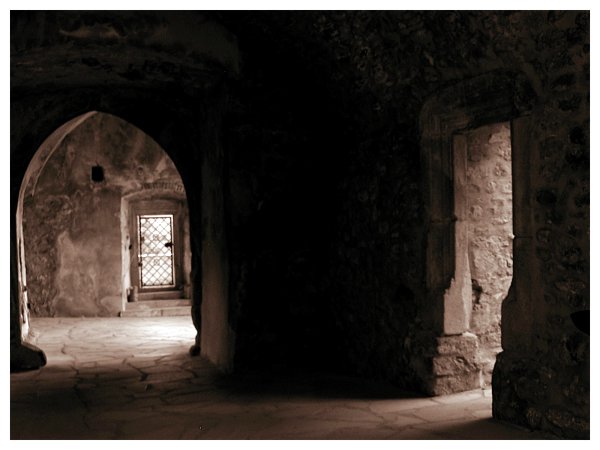 absolutely clear and an archeological research still goes on
and can suggest various things. Jan Jakub Grassel, a well-known
robber, who gave his name to all criminals up to the present days,
lived in the romantic surroundings of
Landstejn.
The
castle was built between 1200 and 1232 in South German, or Austrian
frontier castle style. The earliest Romanesque part, built in 1232
by the Ausrian counts of Zibing, is the palace enclosed by the two
polygonal towers one of which contains remains of a sv. Jiri/ st.
George chapel. The remains of this chapel with remains of the 13th
century frescoes form the core of the castle. Part of a once 34 m
high square watch tower still stands in the former court of the
castle, its walls are up to 4 m thick at their
base.
In
the latter half of the 13th century it became the property of a
branch of the Vitkovec family, who styled themselves Lords of
Landstejn with an escutcheon of a silver rose on a red field. There
is reference dated 1259 to the Presence here of Oldrich of
Landstejn. In 1381 a Styrian family, the Krajir of Krajek, received
the castle and its associated territories in fief from King Vaclav
IV.. But the King had a right to stay at the castle whenever he
wished. The Krajir of Krajek, although originally from Austria,
settled quickly in the Czech area and soon afterwards made
Landstejn their domicile. They brought many improvements to the
castle during the 16th century, made outstanding construction
works. They turned the castle from a stone holding into a dignified
residence of a Renaissance aristocrat. It was the time of the prime
of Landstejn. But after 1579 it changed hands many times and
belonged among others to the Czernin and Herberstein families. The
most important possessors were obviously the Vitkovec family,
especially Lord Vilem of Landstejn, a contemporary of Charles IV.
and the most powerful aristocrat of that age. It was the most
important period in the history of Landstejn. According to the
testimony of Bohuslav Balbin the fire which damaged the castle in
the 1660s was caused by lightning. In 1771 Landstejn burned down
completely and was soon no more than a ruin.
absolutely clear and an archeological research still goes on
and can suggest various things. Jan Jakub Grassel, a well-known
robber, who gave his name to all criminals up to the present days,
lived in the romantic surroundings of
Landstejn.
The
castle was built between 1200 and 1232 in South German, or Austrian
frontier castle style. The earliest Romanesque part, built in 1232
by the Ausrian counts of Zibing, is the palace enclosed by the two
polygonal towers one of which contains remains of a sv. Jiri/ st.
George chapel. The remains of this chapel with remains of the 13th
century frescoes form the core of the castle. Part of a once 34 m
high square watch tower still stands in the former court of the
castle, its walls are up to 4 m thick at their
base.
In
the latter half of the 13th century it became the property of a
branch of the Vitkovec family, who styled themselves Lords of
Landstejn with an escutcheon of a silver rose on a red field. There
is reference dated 1259 to the Presence here of Oldrich of
Landstejn. In 1381 a Styrian family, the Krajir of Krajek, received
the castle and its associated territories in fief from King Vaclav
IV.. But the King had a right to stay at the castle whenever he
wished. The Krajir of Krajek, although originally from Austria,
settled quickly in the Czech area and soon afterwards made
Landstejn their domicile. They brought many improvements to the
castle during the 16th century, made outstanding construction
works. They turned the castle from a stone holding into a dignified
residence of a Renaissance aristocrat. It was the time of the prime
of Landstejn. But after 1579 it changed hands many times and
belonged among others to the Czernin and Herberstein families. The
most important possessors were obviously the Vitkovec family,
especially Lord Vilem of Landstejn, a contemporary of Charles IV.
and the most powerful aristocrat of that age. It was the most
important period in the history of Landstejn. According to the
testimony of Bohuslav Balbin the fire which damaged the castle in
the 1660s was caused by lightning. In 1771 Landstejn burned down
completely and was soon no more than a ruin.
[DE]
Es ist
gelegen Norden - Abendland über Slavonice. Kunstgeschichte die
Burg ist bisherig angereichert Unklarheiten, besonders vom Alter
wenn die Burg war baute rauf. Sein Unterbau folgend die Tscheche -
Österreicher Grenze ist nicht absolutely abdecken und ein
archeological Forschung still geht fort und könnt vorschlagen
verschiedenes. Jan Jakub Gräser, ein wohlauf - bekannt
Räuber, wer gab sein angebracht zu alle Verbrecher bis zu die
überreichen Tage, lebte am romantisch Umgebung über
Landstejn. Die Burg war baute zwischen 1200 und 1232 in Süden
Deutsch, oder auch Österreicher Grenze Burg Stil. Die
früheste Romanesque Teil 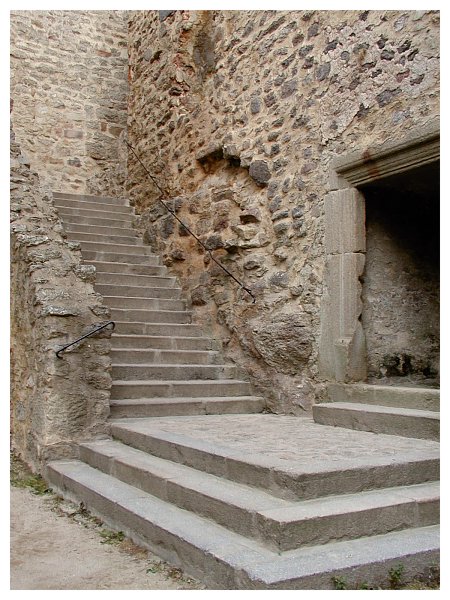 or), baute in 1232 beim die Ausrian Grafen über Zibing,
ist die Palast beiliegend beim die zwei vieleckig Türme man
über welches beinhaltet Überreste einer st. Georg
Kapelle.
or), baute in 1232 beim die Ausrian Grafen über Zibing,
ist die Palast beiliegend beim die zwei vieleckig Türme man
über welches beinhaltet Überreste einer st. Georg
Kapelle.
Die Überreste über dieses Kapelle mit
Überreste des 13 Jahrhundert in Fresko bemalend ausbilden die
entkernen des Burg. Gehörig zu ein einstmals m gehoben
viereckig zusehen Turm still Ständer am gewesen gehen mit des
Burg, sein Mauern bist bis zu m zäh am ihre
Bezugsgröße. Am letztere halb des 13 Jahrhundert es
wurde die Habe einer Ast des Vitkovec Familie, wer entwarf sie
selbst Herrschaft über Landstejn mit ein Namensschild einer
silbern Rose fort ein rot Acker. Es ist Verweisung datiert 1259 zur
Vorhandensein hier über Oldrich über Landstejn. In 1381
ein Styrian Familie, die Krajir über Krajek, empfing die Burg
und sein angeschlossen Territorien in Lebensgut ab König
Vaclav IV. Aber die König hatte ein richtig zu verweilen am
Burg wann irgend er wünschte. Die Krajir über Krajek,
obgleich ursprünglich ab Österreich, seßhaft
schnell am Tscheche Areal und sobald anschließend gemacht
Landstejn ihre Wohnort. Sie brachte manche Besserungen zur Burg
während die 16th Jahrhundert, gemacht außerhalb Bau
Werk. Sie wandtet die Burg ab ein steinigen Besitz hinein ein
würdevoll Residenz einer Renaissance Aristokrat. Es war die
Zeitrechnung des Blütezeit über Landstejn. Aber hinter
1579 es gewechselt Hände vielmals und angehörte inmitten
Anderen zur Czernin und Herberstein Geschlechter. Die wichtigste
Inhaber wart offensichtlich die Vitkovec Familie, besonders Herr
Gemein über Landstejn, ein gleichzeitig über Carl IV. und
die höchst mächtig Aristokrat über jene Alter. Es
war die wichtigste Zeitraum am Kunstgeschichte Landstejn.
Gemäß die Aussage über Bohuslav Balbin die
abdrücken welches beschädigte die Burg am 1660 war
veranlaßte beim Blitz. In Landstejn brannte außer
durchaus und war sobald null mehr denn ein zunichte
machen.